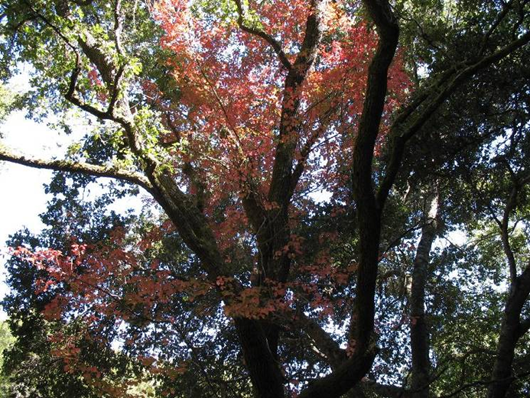
Limited data suggest that poison oak (Toxicodendron diversilobum) can serve as a source of P. ramorum spores. Oaks that are relatively far from infected California bay (>10 m) have an elevated SOD infection risk of disease if poison oak is climbing in their canopies (fig. 1-7). Climbing poison oak is not associated with SOD unless infected California bay is present in the area. Poison oak that occurs as a small shrub or ground cover is not associated with SOD risk in oaks (Swiecki and Bernhardt 2005, 2007, 2008b).

Figure 1-7—Poison oak (in autumn with reddish foliage) that grows extensively in the canopy of susceptible oaks may serve as a source of Phytophthora ramorum inoculum that can initiate trunk cankers on the oak.
Other than California bay, tanoak, and possibly poison oak, none of the other known native P. ramorum foliar hosts (see Sidebar 1-2—Native Foliar Hosts of Phytophthora ramorum) have been associated with disease risk in oaks or tanoak in California forests. Infections on many of these other foliar hosts typically develop only under very wet conditions when inoculum levels from California bay and tanoak sources are very high. The small amount of additional inoculum that may be produced on these hosts is likely to have little or no effect on overall spore numbers. Many of these other foliar hosts tend to shed infected leaves readily, which further reducing their ability to produce spores. Finally, spores produced on low-growing understory species can only move one to a few meters horizontally (Tjosvold and others 2006). P. ramorum infections on other foliar hosts indicate that high inoculum levels are present, but do not appear to contribute to disease spread.
Rain washes P. ramorum spores into soil and surface water. Splash dispersal from infested soil or watercourses is only likely to transport inoculum up to a meter laterally and a half meter vertically. California bay or tanoak foliage on seedlings and low hanging branches may be infected by splashing of inoculum from soil or streams, but the small amount of spores transported in this way is unlikely to initiate trunk canker infections. Flooding of P. ramorum-infested streams has also been associated with the development of foliar infections on inundated hosts. Heavily infested soil or water that is directly deposited on oak trunks by human or animal vectors may initiate trunk infections, especially if the inoculum is introduced into bark wounds. This infection pathway may account for some of the uncommon trunk cankers seen in oaks without nearby California bay trees.